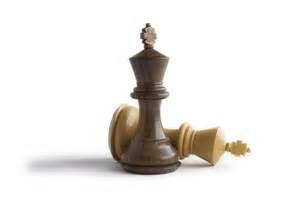
Chess in Black and White: Endgame Lesson 3 - The Power of the King!
To get the most out of these lessons make sure to join the study group. The link is at the bottom of the lesson. If you missed the intro to the series you can find it here -
http://www.chess.com/blog/MichaelPorcelli/chess-in-black-and-white-issue-18-free-endgame-course
and lesson 1 here
http://www.chess.com/blog/MichaelPorcelli/chess-in-black-and-white-endgame-lesson-1
and lesson 2 here
http://www.chess.com/blog/MichaelPorcelli/chess-in-black-and-white-endgame-lesson-2---pawns
The power of the king!
It may feel as if we are going to be harping on this point, but it cannot be said enough, your king is powerful in the endgame!
Beginners
a. Your king is a defender and an attacker, so use him as both. You should know the basic checkmates such as King and Queen vs a lone king and King and rook vs a lone king. Notice that without you king both defending and attacking the lone rook or queen is useless by itself.
b. Your king should be in the center of the board. As soon as you conclude you have entered the endgame the best place for your king in most games will be the center of the board. From here your king can quickly be dispatched to where he is most needed. The reason this is so important is because the king is SLOW and being in the center keeps him close enough to all the action to hopefully help.
c. Your king should be leading the charge as the board clears. Having you king is the center is great, having your king behind enemy lines is usually winning. This is even more true in endgames where there are no rooks or queens. Since pawns cannot attack or move backward your king can easily snatch them up once behind enemy lines.
d. Your King needs to PULL your pawns along. Once your king is in front of your passed pawn(s) he can clear the way and walk with them down the board to victory. Letting your pawn go on alone is very dangerous unless that who side of the board is already clear of enemy pawns, pieces, or the enemy king.
Intermediate
a. Many endgames appear as a series of trades happen in a relatively few number of moves. Many time the chess player is not sure when to trade rooks or bishops. Make sure when deciding that you are looking at the king position for both you and your opponent. If your king can get to the center first, or start attacking pawns first, then trading off towards an endgame is a good idea. However if your king is far away from the action see if you can get him closer before trading off pieces such as rooks.
b. This is the point in your chess learning where you should start occasionally focusing on learning a term and how it applies to the game. Opposition is the term I want you to learn this week. This is where neither side can make progress. Obviously there is more to the concept than that, so if you want to get good go learn it, and then next week I will include the main points to see if you are on track. This concept is especially important when trying to save endgames where your position looks worse. And it will help you to avoid letting your opponent save games where your position is better.
Advanced
a. Sometimes to win one must not go forward. Building on the concept of opposition, it is important to remember that not only do you want your king to get to key squares first, but it must also be at the right time. Try to come up with an example of a position where to win one must take a less direct route with the king to capture a pawn and or get to a key square.
b. Hopefully the following terms are at least a little familiar to you. Zugzwang, trebuchet, opposition, and triangulation. Try to define these terms and come up with an example, without any research or board. If you get stuck then use a board, and if you are still stuck after that then do some research. All concepts will be reviewed next week to make sure you are on the right track, but working on the homework will benefit you the most.
Challenge:
In the endgame visualization is even more important because often you need to see ahead further and calculate out king and pawn races, and different pieces covering the whole board over a series of turns. As a result your challenge is to try to play 2 blindfolded games this week, so any game where you cannot see the board. If you can, after you get as far as possible for you set up the position and post it in the group. An added level is to post the whole game from your head, move by move.
Thank you for reading and I hope you will join again next week when we look at an example game and review what has been covered thus far! Remember to join the study group if you have yet to do so, and post your work in the forums. Feel free to post any feedback/suggestions/comments and I would be happy to respond.
Have a great week and good luck in all your games!
-Michael Porcelli
Study Group -
http://www.chess.com/groups/home/mps-endgame-class
Study forums by level -
http://www.chess.com/groups/forum/mps-endgame-class
All material and information is owned by Michael Porcelli and Chess in Black and White. Copyright 2015 all rights reserved.